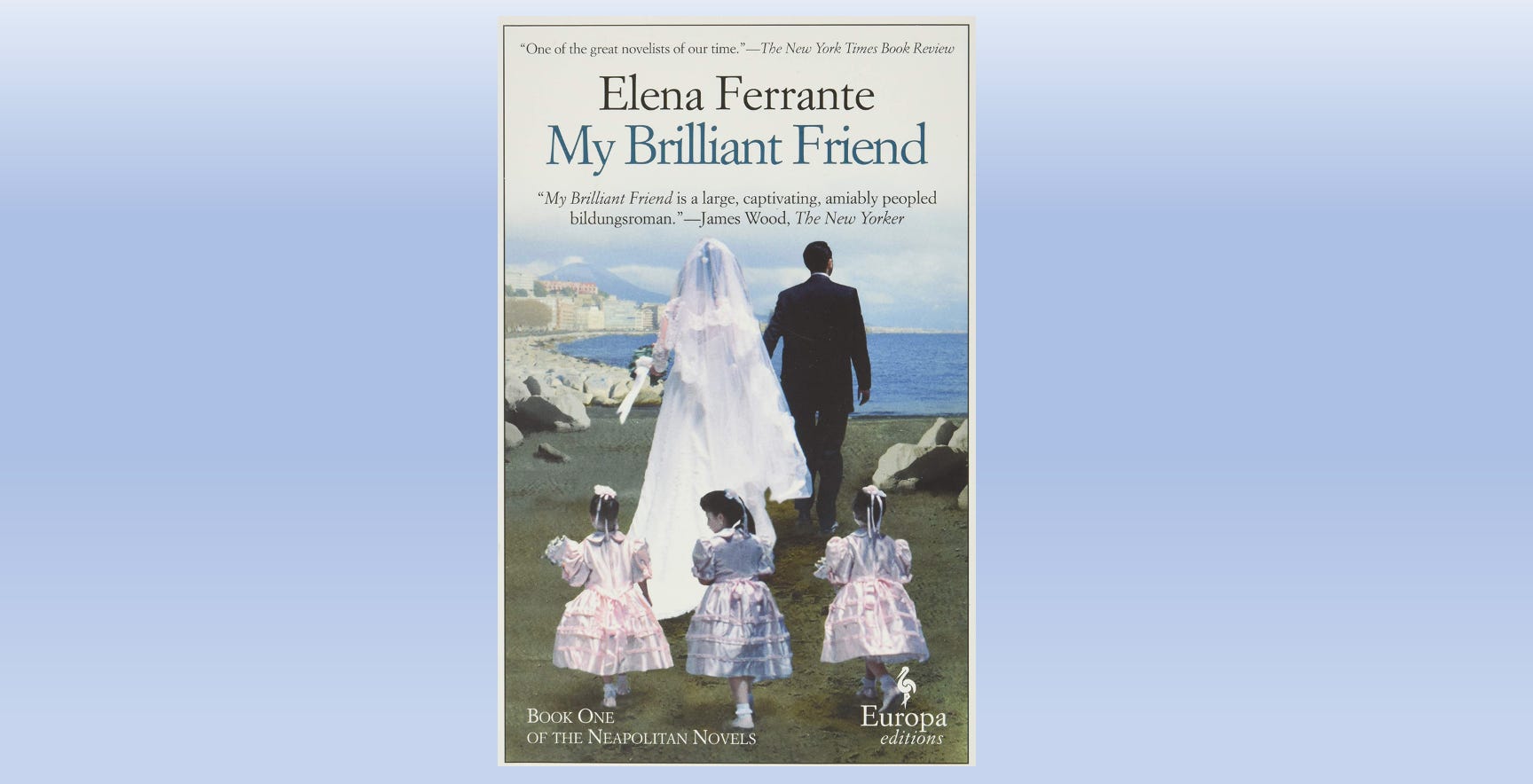Yesterday the New York Times announced its choices for the ten best books of the 21st century—the final step in its countdown of the top 100. Eight out of the top ten selections have already been reviewed here at The Honest Broker—in a section called The Vault (for premium subscribers). Many other titles in the top 100 have also been discussed here
Today I’m sharing a review of the Times pick for best book of 21st century—removing it from behind the paywall. The book is My Brilliant Friend by Elena Ferrante. By the way, here’s a list of the top ten—with links to my reviews at The Honest Broker. (10) Gilead by Marilynne Robinson The Honest Broker is a reader-supported guide to music, books, media & culture. Both free and paid subscriptions are available. If you want to support my work, the best way is by taking out a paid subscription.The Times list is better than I might have expected—probably a result of inviting some genuine experts to serve among the 500+ voters. But it is still too heavily tilted to books in English. And its notion of diversity is still too heavily determined by influential voting blocks in US elections—a small subset of the actual ‘diverse’ world. This is perhaps another way in which US politics makes us all dumber. There is a whole rich world of creative experience out there, and perhaps not all of it seen clearly from the vantage of Midtown Manhattan. But, all things considered, the Times has done a fairly credible job here. Below is my assessment of the top book in the Times hierarchy—My Brilliant Friend by Elena Ferrante. What Do You Do with a Brilliant Friend?Essay by Ted Gioia I’ve heard readers of My Brilliant Friend describe it as an American rags-to-riches tale transplanted to 1950s Naples. At first glance, this description seems apt. The characters show the same kind of zeal for raising their standards of living, and reinventing themselves according to the measure of their own ambitions that we have seen in such quintessentially American novels as The Great Gatsby or The USA Trilogy. And it’s true that, instead of the dominant traditions, pervasive religiosity, and quotidian concerns, we associate with working-class Southern European small town life during this era, Ferrante describes something very different. Her Naples is a fluid meritocracy marked by continual social churning. Here visionary individuals can recreate their lives based on sheer grit and the capacity to dream big dreams. Even the epigraph to the book creates the beguiling (but perhaps misleading) impression of a society in which abilities and hard work are recompensed with suitable rewards. Ferrante draws upon Goethe’s words—”thou'rt free according to thy merits”—to convey this equation on the opening page of her book. We are free according to our merits? Could Elena Ferrante really be a kind of Neapolitan Ayn Rand? Some suspect as much: Lit critic Jon Baskin has suggested that “it may prove a mistake to presume, as some critics have, that Ferrante’s novels endorse ways of thinking familiar from leftist theory or even from liberal politics as we typically understand them.” But, as we shall see, Ferrante’s vision of a meritocracy is very different from laissez-faire capitalism. But I’m hardly surprised at the confusion among some readers. Ferrante deliberately sows it. In these pages, a railroad conductor can become a published poet. A cobbler’s son can launch his own brand of fancy designer shoes. But the character with the greatest capacity for self-reinvention is the narrator’s friend Lila Cerullo. Lila seems to do everything with ease—whether passing exams or attracting suitors. We follow her during her teen years, as she achieves success after success, only to cast each opportunity aside to pursue another. Before the novel reaches its conclusion, she has achieved a level of glamor equivalent to a movie star or fashion model, both fascinating and frustrating family members, friends, and neighbors who denounce Lila’s airs, yet can’t help falling under her spell. In such scenes, Ferrante seems to borrow many of the familiar formulas of the coming-of-age novel. But almost every one of these formulas is subverted or reversed during the course of the book. Even the title is a clever piece of misdirection. As readers eventually discover, the brilliant friend isn’t the narrator’s talented alter ago Lila, whose personality dominates the book. Instead it is the narrator herself, Elena Greco, a stand-in for our author. Elena is the daughter of a porter who works at City Hall, and her daily life is limited even by the standards of her time and place. Although she lives in Naples, she has never even seen the sea. She excels at schoolwork, but her parents are reluctant to send her to middle school, let alone high school and college. Her future promises to be a modest one, perhaps as a housewife or clerk in a retail store. Elena becomes more ambitious as the novel progresses, and along the way she is encouraged by teachers and admirers, who sense that she has potential to rise above her circumstances. The reader is now convinced that Elena Greco, our protagonist, is a stand-in for Elena Ferrante the author, and this brings with it certain expectations—most notably that the book will conclude with the familiar triumphs of the American-style rags-to-riches tale. But Ferrante violates almost every one of our expectations. We come to assume that the book will conclude with Ferrante’s heroine embarking on a career as a writer—a formula familiar to us from the semi-autobiographical works of Joyce, Proust, and others. But My Brilliant Friend ends with a rejection from a periodical—the last thing the reader expects from the elaborate set-up of the preceding 300 pages. Ferrante also creates other frustrated expectations—that her heroine will escape from the impoverished life of her village, that she will form a romantic attachment with the intense, moody poet’s son she has been brooding over for most of the book. Here, too, the resolutions we are given are hardly the ones we expect. In other words, Elena Ferrante has done the exact opposite of what many claim. Instead of transferring the “American dream” to impoverished Naples, she has actually embraced the fatalistic view, so common in traditional Catholic societies, that destiny is more powerful than our aspirations. She tells us that our capacity for self-reinvention is sharply constrained at every turn. The railroad conductor who becomes a poet eventually reveals himself as a shallow narcissist—he doesn’t even know the most basic facts about literature. The ambitious entrepreneur finds that no one wants to buy his designer shoes. Even Lila, gifted and glamorous, will continue to struggle to escape the violence of her Neapolitan origins. As the novel progresses, we sense more clearly the Old World constraints that circumscribe our characters. Acts of violence are necessary to uphold family honor. Relation between teenage males and females are scrutinized by parents and neighbors, who insist on time-honored principles of decorum and propriety. Above all, we find the Italian concern with fare una bella figura—putting on an impressive appearance, a certain look and attitude. The image of success is almost more important than any financial measures of its magnitude. We have now left the Horatio Alger rags-to-riches story far behind. This sense of a constraining destiny is especially evident in the novel’s secondary characters—and these play a prominent role in the book. Ferrante even provides a guide to the nine different families involved in her tale, as well as other parties who help propel the narrative forward. The conflicts and rivalries will dominate the book, and though many of these friends and neighbors have dreams and ambitions, their freedom to act is limited at every hand. Almost everyone here will end up in a situation not much different from where they started out. And those who dream the most are merely those most likely to suffer the greatest disappointments. So this book is not so much a bildungsroman as one of those haunting stories about alter egos—I’m reminded of Henry James’s “The Jolly Corner” or Edgar Allan Poe’s “William Wilson” where a character defines itself through another person who is both a kind of twin and a potential nemesis. Elena Greco isn’t really driven by her ambitions in these pages, but rather by a kind of mimetic relationship with her friend Lila. She tries to lead the life that Lila might have pursued under more favorable circumstances. We anticipate that Elena will eventually parlay her intelligence and skill as a writer into finding a different path—as Ferrante outlines in the subsequent novels in this tetralogy. But does she really overcome destiny through Yankee-ish stick-to-it-iveness? Or does she hold on to the familiar and time-honored? Perhaps the best way of answering that question is by looking at the other Elena, the one who wrote these four novels about Naples. We would like to know more about her, but who can doubt that in the novelist’s escape from the world and imaginary immersion in her native soil, how she has resolved that particular trade-off? Our author has escaped from the real world into the more transcendent world of art, creativity, and imagination—where the mean streets of Naples no longer touch us. Her characters have a chance to do the same. And maybe her readers too. You're currently a free subscriber to The Honest Broker. For the full experience, upgrade your subscription. |
Search thousands of free JavaScript snippets that you can quickly copy and paste into your web pages. Get free JavaScript tutorials, references, code, menus, calendars, popup windows, games, and much more.
The Best Books of the 21st Century
Subscribe to:
Post Comments (Atom)
Top 3 UX Design Articles of 2024 to Remember
Based on most subscriptions ͏ ͏ ͏ ͏ ͏ ͏ ͏ ͏ ͏ ͏ ͏ ͏ ͏ ͏ ͏ ͏ ...
-
code.gs // 1. Enter sheet name where data is to be written below var SHEET_NAME = "Sheet1" ; // 2. Run > setup // // 3....



No comments:
Post a Comment